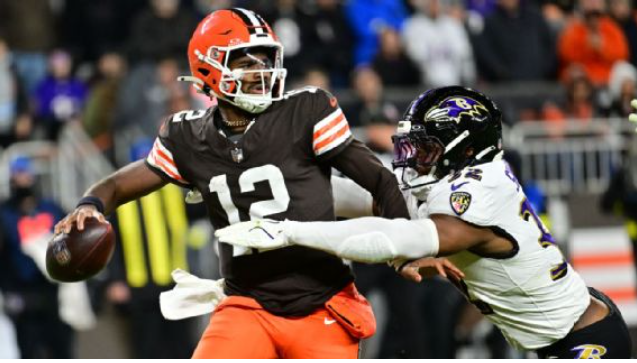Sports
Tough Debut: Shedeur Sanders Takes the Reins After Gabriel’s Injury
1. Sudden Call to Action: Gabriel’s Exit and Sanders’ Arrival
The Cleveland Browns faced a dramatic turning point during their matchup when starting quarterback Dillon Gabriel exited the game after sustaining a concussion in the third quarter. His injury, which occurred after a hard tackle, left the Browns without their lead signal-caller for the remainder of the contest. With little warning and no gradual buildup, rookie quarterback Shedeur Sanders was suddenly thrust into action for his NFL debut.
As Shedeur Sanders stepped onto the field, fans filled the stadium with chants of excitement, hoping he could inject life into an offense that had struggled to build momentum. Gabriel had completed 7 of 10 pass attempts for 68 yards before his injury, showing flashes of rhythm but not enough consistency to give the Browns comfort. Sanders now had the responsibility of guiding the team forward — a challenge made even more daunting by the limited reps he’d taken with the starting unit in practice.
The abrupt shift underscored the volatile nature of the quarterback position in professional football. One play can change everything, turning a developing season into a test of resilience and adaptability. Sanders found himself standing at the intersection of expectation and pressure, forced into a moment bigger than anything he had yet experienced in the league.

2. A Rough First Outing: Challenges, Struggles, and Learning Curves
Shedeur Sanders’ debut proved to be a steep learning curve. He finished the game completing 4 of 16 passes for 47 yards. The Ravens defense pressured him heavily, forcing an interception and a fumble — though the Browns were fortunate to recover the latter. Sanders was also sacked twice, adding to the difficulty of finding rhythm in a high-stakes environment.
After the game, Shedeur Sanders was candid in his self-assessment, acknowledging that he didn’t perform at the level he expected. He noted the lack of timing with the receivers, explaining that he’d spent most of the season practicing with reserve units instead of the starters. This gap became evident on the field, where routes felt mistimed and chemistry appeared unrefined.
Head coach Kevin Stefanski expressed support for Sanders, emphasizing that every backup — especially a rookie — faces challenges when unexpectedly thrust into a live NFL game. Stefanski highlighted that Sanders had shown promise, but that the situation made the transition difficult. In an offense designed around Gabriel’s strengths, Sanders had to improvise on the fly, contending not only with the opposing defense but with unfamiliar pacing and game dynamics.
Despite the struggles, the outing provided invaluable film and experience for both Sanders and the coaching staff. It offered a clearer picture of where improvements are needed and what adjustments could help accelerate his development.
3. Context, Expectations, and the Browns’ Quarterback Landscape
Shedeur Sanders’ debut carries added weight given the expectations that have followed him throughout his football journey. Coming out of college, many analysts expected him to be a first-round pick. Instead, he fell to the fifth round of the draft, selected 144th overall by the Browns — a surprising slide that drew widespread attention.
Part of that drop stemmed from concerns about how his play style would translate to the NFL, as well as questions about durability and decision-making. Meanwhile, Gabriel — drafted in the third round — had been given the reins to lead the offense early in the season. With practice reps focused largely on Gabriel, Shedeur Sanders saw limited time working with the core offensive unit.
The Browns’ 2-8 record only intensified the situation. A struggling team often looks toward its quarterback for stability and direction. Gabriel’s concussion added uncertainty to an already unstable quarterback situation, prompting analysts and fans to debate how the Browns should move forward. Should they continue developing Gabriel? Should Sanders be given more opportunities? Or should the team consider larger strategic shifts?
Shedeur Sanders’ debut was more than a single game — it was a glimpse into the future, a reminder of how quickly the trajectory of a franchise can change when a young quarterback is thrust into the spotlight.
4. Team Response: Unity, Accountability, and Support
Following the loss, the Browns’ locker room rallied behind Shedeur Sanders. Veteran defensive leader Myles Garrett made it clear that the team refused to let the rookie shoulder the blame. Garrett emphasized that football is a team sport, and mistakes, missed opportunities, and challenges belong to everyone, not just the quarterback.
Offensive tackle Wyatt Teller echoed this sentiment, highlighting that Sanders had barely worked with the starting group before the game. Teller noted that he had heard Sanders’ cadence only a handful of times, reinforcing how abrupt the transition had been. Despite the obstacles, he praised Sanders’ effort and heart, stating that the young quarterback gave everything he had in a difficult situation.
Sanders, for his part, maintained a positive attitude. He acknowledged the mistakes but emphasized the importance of growth. He expressed excitement about finally returning to live-game action, noting that being hit again — truly feeling the speed and physicality of the NFL — helped him reconnect with the rhythm of competitive play.
The coaching staff now faces a critical decision: prepare for Gabriel’s return once he clears concussion protocols or allocate more practice reps to Sanders to accelerate his development. Whatever direction they choose, communication and unity will be key in maintaining morale and forward momentum.
5. Looking Ahead: Development, Strategy, and Long-Term Implications
For Sanders, the debut represents both a challenge and an opportunity. The areas for improvement are clear: quicker decision-making, improved accuracy, stronger pocket awareness, and better connection with receivers. His potential remains undeniable, but the gap between potential and production must be bridged through preparation and tailored coaching.
For the Browns, the situation is a revealing moment. The team must evaluate whether its quarterback development strategy is sustainable. Drafting two rookies, building an offense primarily around one, and shifting unexpectedly to the other has exposed weaknesses in their preparation systems. Strengthening depth, improving practice rotation, and creating flexible game plans may become priorities moving forward.
The fan base will also be watching closely. Whether Sanders emerges as the franchise quarterback of the future or remains a developmental project depends on how he — and the organization — responds from this point forward. Growth is rarely linear in the NFL, and rookie quarterbacks often stumble before they soar.
In many ways, Sanders’ debut was not about the numbers but the moment — the willingness to step into uncertainty, face adversity, and take the first step in a long journey. If he continues to approach the game with humility, determination, and a willingness to learn, the experience could become a defining chapter in his professional rise. For now, both he and the Browns prepare for the next test, united in the hope that better days lie ahead.
From: Candourroyaltees
